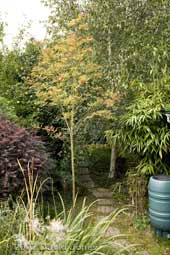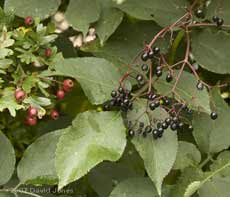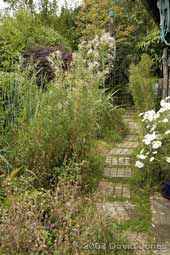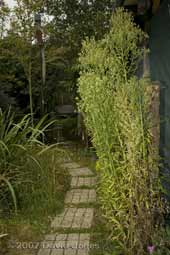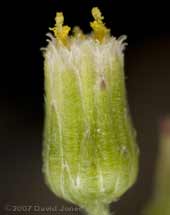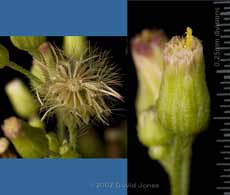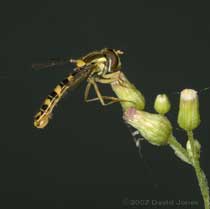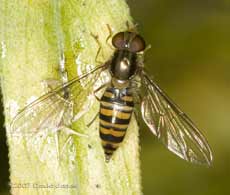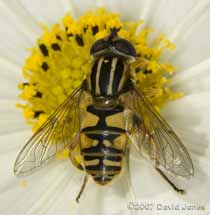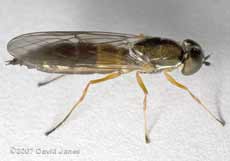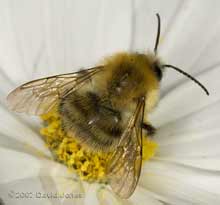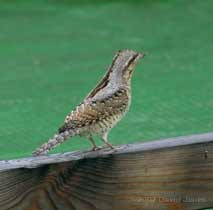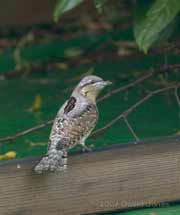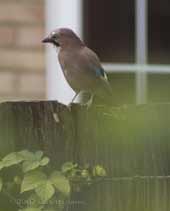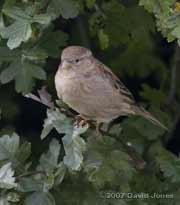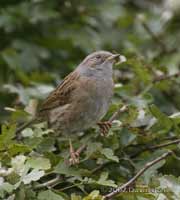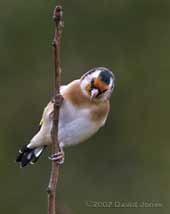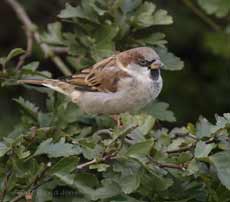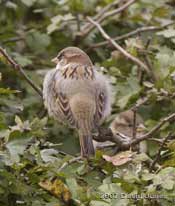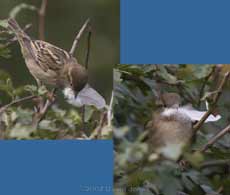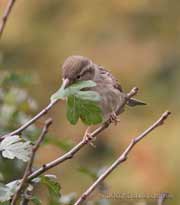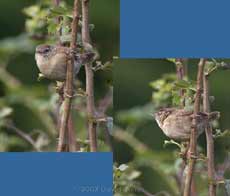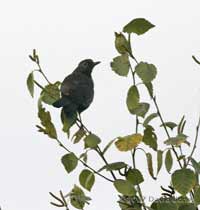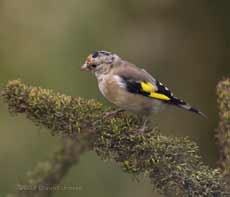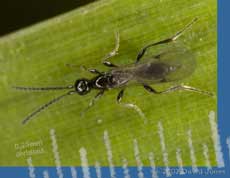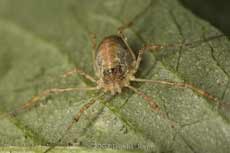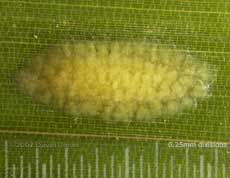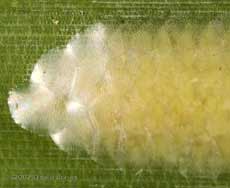Go to the last entry on this page ... .....Go to previous entry19 September - An attempt to get the diary going again, with nearly a month gone by since the last entry. We managed to get the bedroom finished (other than a new door, which is yet to be added), and we are very pleased with the result, but it has meant that I've been able to do very little since then. I don't think I picked up my camera for the remainder of August, and it's only in the last few days that I have started taking any photographs. After the poor weather that contributed to the loss of the House Martins, things brightened up a bit during the last week of August. However, it seemed that all the local Martins must have left as I saw no more in the skies over us, unlike last year when they were with us well into September. Here in the garden, In addition to our resident House Sparrow flock (often being very noisy in the hawthorn), the Goldfinches have flourished and we are getting up to 15 adults and juveniles feeding here several times every day, getting through large quantities of Sunflower kernels! Daily visitors also include Great Tits, Blue Tits, Robins, Collared Doves and Wood Pigeons. Dunnocks have also started feeding here again after a gap of several months. We see just the occasional Starling, but while I hear Blackbirds around the far end of the garden, they don't make any appearances near the house. Over the last week I've also seen a couple of visits to the bird table by a Coal Tit. After the appearance of the young hedgehogs in August, there have been no daytime appearances during September, and I'm not seeing any small hedgehogs when I do look out in the late evenings. The appearance of droppings shows that there is night-time hedgehog activity in the garden and I do see an adult coming to feed most evenings. The first part of September has been dry here - I even needed to top up the big pond after I had allowed the level to fall to its lowest level of the year. Today there were a few moments of dampness , although hardly enough to need an umbrella, but it seems that we should have rain by the end of the week.
Autumn is certainly starting to make itself felt now. The Rowan's leaves have started turning red, and the red of its berries really stand out from the green background. The Rowan is now about 4.2m tall.
Nearer the house, and next to the Hawthorn with its red berries, the berries on the Elder are a shiny black colour and it looks as though a bird has already been tucking into them.
Up on the West Wing, the Chilean Potato Vine was very disappointing this year, producing huge amounts of leafy growth but very few flowers. I have pruned it back quite drastically. I'm considering training Ivy up the fence instead of (or as well as) the vine. The Ivy tree still has its list and I'm afraid that it will not survive the Winter, so I'm looking at the best way to replace it. Having cut back much of the Ivy tree to reduce the danger of it falling over, it will not have a good crop of flowers and berries this year, except for the side facing my neighbour's garden. Some flowers are already open, so I will have to watch out for insects that visit them in the weeks to come.
Another job that I've done over the last week has been to move the stepping stones that pass between the big pond and the caravan shelter. On the basis of how well plants have grown to the right of the path this year I've moved the stones more to the left, making the path meander more than previously. In this picture you can see the Great Willowherb plants on the left, still producing a few flowers. On the right you can see some of the Cosmos flowers that have been a great success with the bees this summer (although the flowers need dead-heading every day!)
Beyond the Cosmos you can see another plant that has thrived this summer, having appeared here for the first time this year. It has grown to almost 6ft in height in a quite compact column, with lender, simple and stalk less leaves around the lower stems and a much branched top end, with each stalk ending in a very small flower. It has been in flower for most of August, and they continue to be produced at the moment. They are no more than 4mm long, less than 2mm across and with no obvious petals.
Taking a close look at a flower reveals that there are a large number of tiny white petals, and the flowers that are 'in bloom' have minute yellow structures. These appear to bear pollen, but I'm not sure if they also incorporate a stigma. I can only see a few of these structures on any one flower, but the number of seeds produced suggest that many more develop during the life of a flower.
As the flower ages, the top turns somewhat reddish and eventually produces what resembles a tiny version of a dandelion seed head. I'm having trouble identifying the plant(s). They appear to be some sort of Fleabane, possibly Canadian Fleabane (Conyza canadensis), although these specimens seem to be too tall and the flowers (florets) too narrow.
Whatever the plant is, its flowers are regularly visited by various small hoverflies. It appears to be Sphaerophoria scripta, an abundant species on grassland and urban wasteland! It measures about 12mm in length.
This individual, also measuring around 12mm, was 'sunbathing' on one of the plant's leaves. I think it is Episyrphus balteatus, another abundant species, in gardens.
While most of the hoverflies that I have seen over the last week have been of small species, there are larger types about as well, such as this Helophilus species (likely to be H. pendulus). To give an idea of scale, the centre of the Cosmos flower is about 12-14mm across.
Over the last week or so I have been seeing numerous of this type, not on flowers but 'trapped' up under the transluscent roof of the veranda. It seems that once under the roof panels they continue to try flying towards the light! They measure about 13mm in length and seem to be a species of the genus Platycheirus.
There are still bumblebees visiting the garden, albeit in small numbers, and nearly always to visit the Cosmos flowers. They all seem to be carder bees, but not from our bumblebee nest - that colony died off several weeks ago.
29 September - Getting back into the swing of doing things in the garden and taking photographs is proving harder than I thought, but an event this morning cannot go without being recorded - a rarity paid us a visit. During this last week the weather has turned decidedly autumnal. We have started using the log burner as the daytime temperature has dropped to the low teens. At the beginning of the week we had heavy rain with squally winds, and few miles away in Farnborough houses were damaged by a tornado. We had heavy rain for a while yesterday and again this morning. Two days ago I happened to look out of our bedroom window while a male Greater Spotted Woodpecker was feeding at the tall peanut feeder. By the time I collected my camera from downstairs it had left, so I decided to leave the camera in the bedroom ready for its return.
On our caravan shelter was a very different kind of woodpecker, a Wryneck. The guides were needed as this is the first time I have ever seen one of these rarities. With perhaps just six pairs nesting in the UK, this bird is one of just a few hundred that pass through the south and east coastal areas of the UK during the Autumn and then again in Spring, although they do not over-winter here. I believe it is quite unusual to see on this far inland.
It was here just after 11am this morning, and although I have watched out for it during the rest of the day it hasn't reappeared, so I guess it has moved on. It feeds almost exclusively on ants, and its plumage has an impressive mixture of textures that will help camouflage it when it is amongst the branches of a tree. Fortunately, it stayed out in the open long enough for me to take these photographs.
Even taking into account the Waxwings that came to visit in 2006, this has to be the most unusual visitor that we have ever had in our garden. The only pity is that it had disappeared before Sheila could get to the bedroom to share the sight with me. At least she was able to see the photographs, although they are a poor substitute for the real thing.
As I watched and waited for its possible return, a Jay turned up at the bottom of the garden. It stayed largely hidden behind the Birch tree and I was only able to get this poor shot of it when it flew out of the garden and perched on a fence a few gardens away.
Having recorded these two visitors, I also took a few photographs of our regulars (although I won't call them ordinary!). First, one of our House Sparrows, a female. The sparrows continue to gather in a flock of up to around 30 birds in and around the Hawthorn, with many of them emerging out of the top of the tree every time the sun shines. Interestingly, their dedicated feeder (filled with budgie seed) isn't being emptied as quickly as it was a couple of weeks ago. There was at least one large dragonfly flying about this afternoon and one of the sparrows tried to catch it when it passed too close to the Hawthorn. The Sparrows have had to avoid the clutches of a Sparrowhawk during at least one attack this week. In contrast to the sparrow numbers the Dunnock, while now a regular again, is a solitary visitor. This picture was taken while the Dunnock had the Hawthorn more or less to itself. It spent several minutes moving about in the tree, emerging frequently before disappearing back into the foliage.
It was difficult to get any photographs of them from the bedroom as they swooped low into the Buddleia before approaching the feeders. I also had the same problem with the Great and Blue Tits that were visiting the bird table to collect bits of chopped peanuts.
On a larger scale, the Collared Doves and Wood Pigeons continue to do a grand job of cleaning up spilled seed, as well as making the occasional raid on the feeders themselves. During the day there was quite a bit of activity at the far end of the garden with at least three Blackbird males coming and going, as well as a couple of Robins, at least one of which made a few visits to the bird table during the day. I haven't seen a Blackbird near the house for quite a while now. I see that most of the Elder berries have been eaten Down amongst the plants the Cosmos are still doing their job with the Carder Bees continuing to visit today. I need to do a bit more tidying up over the next few days. On a down note, I found a freshly produced Harlequin ladybird pupa on a bamboo plant a couple of days ago. It seems that their insidious encroachment continues. Fortunately, I have yet to find any on the Birch tree where the Orange Ladybirds are still holding their own! I should finish by saying that I have managed to add the large images for both of this month's entries. Hopefully things will start to get back to normal as we head into October!
30 September - A largely overcast day, but dry, and with no sign of the Wryneck - I guess that it has moved on. I must try to find out where it would have come from, and where it was heading as it is unlikely to over-winter in the UK.
With the camera still set up at our bedroom window I couldn't resist a few more pictures of our 'regulars'. First, after including a female House Sparrow in yesterday's entry I thought I should add a male sparrow today.
As usual, and despite the lack of sunshine, groups of sparrows spent time perched on the upper branches of the Hawthorn. With the temperature not getting above 15C some fluffed themselves up while they perched.
Sparrows go to the nest boxes frequently throughout the day, and occasionally I catch a glimpse of bedding being taken up to them. In this case the female arrived at the Hawthorn with a feather, and spent several minutes there before heading to one of the boxes above our bathroom window.
A bit later I was surprised to see this sparrow tear off a piece of Hawthorn leaf to take to a box.
Watching the sparrows and Goldfinches, I nearly missed this Wren when it appeared suddenly from below the Buddleia, pausing for just a few seconds near the top of the Hawthorn before flying off. The Wren has been only an occasional sighting in the garden this year, so this was a very welcome sighting.
The Blackbirds continued to move about largely out of sight (but not earshot) beyond the Birch, but this one flew up to the top of the Birch, pausing just long enough for me to get one shot before it moved on. It looks like a juvenile - I have yet to see an adult here since mid-summer.
For a final bird picture, another juvenile Goldfinch, this one younger than yesterday's example and with the typically scruffy head plumage displayed by the majority of the flock that feeds here. When one perches on a Buddleia flower/seed head it usually has a peck at the developing seeds before moving on to the feeders.
For the first time in a while I actually spent some time wandering the garden today, and have to note that Harlequin Ladybirds are definitely part of the garden fauna now. While I didn't see and larvae or adults I found three pupae, on on a bamboo leaf, another on the side of a plastic container, and worryingly, on a Birch leaf. It's interesting to note that the ones on the bamboo and the Birch were on the upper surfaces of the leaves. On the Birch the Orange Ladybird pupae are always on the leaf underside. In fact, I found fifteen of these during a brief check of the birch this afternoon - also four larvae but just one adult Orange Ladybird.
There were numerous small flies on and under leaves at the bottom of the garden, many similar to this one, which I believe is a gall wasp of some sort. I shall have to get some more photographs of other types.
Harvestmen are much in evidence at the moment, although I only took this photograph today. It looks like Paroligolophus agrestis, a very common species (thanks to Bob Saville of the Lothian Wildlife Information Centre). There are several other species in the garden and I hope to add more pictures soon.
Finally, one of those puzzles that my guides fail to provide an answer for. On the top of a bamboo leaf is this structure, measuring just under 7x3mm. It is almost flat and has a scaly looking surface. I used a ring flash to light it for this photograph, showing something of the internal detail.
However, I first noticed it because it appeared to be almost pearly white when looked at in natural light. In this second photograph I illuminated it from one side to show that effect. Am I looking at a group of developing embryos? If so, I would expect rather more uniformity between the individual structures that show up in the first picture - any suggestions? Click on images to see larger versions |
|
